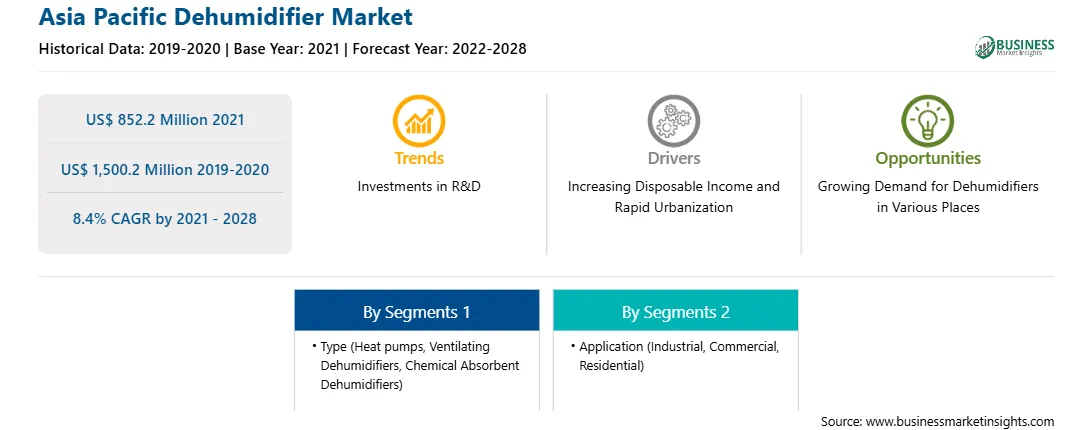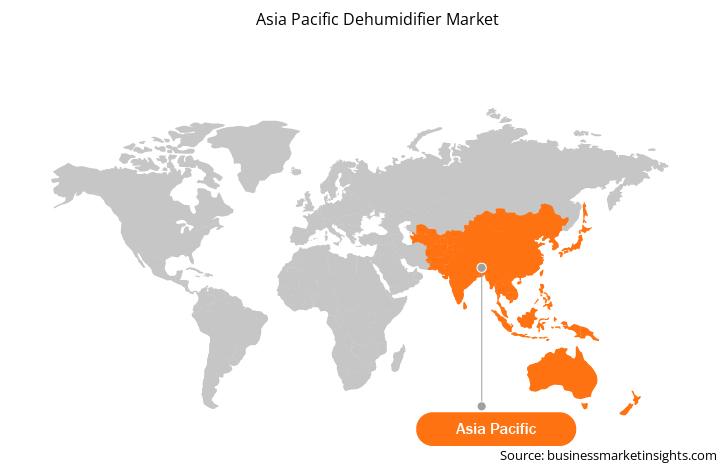This research report on the “Dehumidifier Market” provides a holistic view of the market size across major regions. The report further elucidates the key driving factors, restraints, growth opportunities, and future trends pertaining to the market growth.
Moreover, the rapid urbanization and growing disposable income is expected to bolster the market growth during the forecast period.
Barring few developed countries, Asia Pacific region is still considered to be in developing state. These developing countries do not have required health infrastructure and this led to the increase in the count of recorded cases in 2020. As per the Organization for Economic Co-operation and Development (OECD), the pandemic has affected significant economies such as Australia, India and Japan. Due to inadequate health and medicine facilities, government authorities had to impose restrictions of limited workforce at production sites. Also in some countries, transport of non-essential goods was restricted. Also, as per the Purchasing Managers' Index surveys, manufacturing indices in Indonesia, Vietnam, and the Philippines also fell considerably. Due to restriction of movement from one place to another, many companies gave work from home. Owing to this, demand for residential dehumidifiers is expected to have increased respectively. In 2021, with increasing vaccinations and easing of restrictive measures, various industries have started their operations. Post pandemic, Asia Pacific dehumidifiers market is anticipated to grow promisingly.

Strategic insights for the Asia Pacific Dehumidifier provides data-driven analysis of the industry landscape, including current trends, key players, and regional nuances. These insights offer actionable recommendations, enabling readers to differentiate themselves from competitors by identifying untapped segments or developing unique value propositions. Leveraging data analytics, these insights help industry players anticipate the market shifts, whether investors, manufacturers, or other stakeholders. A future-oriented perspective is essential, helping stakeholders anticipate market shifts and position themselves for long-term success in this dynamic region. Ultimately, effective strategic insights empower readers to make informed decisions that drive profitability and achieve their business objectives within the market.

| Report Attribute | Details |
|---|---|
| Market size in 2021 | US$ 852.2 Million |
| Market Size by 2028 | US$ 1,500.2 Million |
| Global CAGR (2021 - 2028) | 8.4% |
| Historical Data | 2019-2020 |
| Forecast period | 2022-2028 |
| Segments Covered |
By Type
|
| Regions and Countries Covered | Asia-Pacific
|
| Market leaders and key company profiles |
The geographic scope of the Asia Pacific Dehumidifier refers to the specific areas in which a business operates and competes. Understanding local distinctions, such as diverse consumer preferences (e.g., demand for specific plug types or battery backup durations), varying economic conditions, and regulatory environments, is crucial for tailoring strategies to specific markets. Businesses can expand their reach by identifying underserved areas or adapting their offerings to meet local demands. A clear market focus allows for more effective resource allocation, targeted marketing campaigns, and better positioning against local competitors, ultimately driving growth in those targeted areas.

The Asia Pacific dehumidifier market is projected to reach US$ 1,500.2 million by 2028 from US$ 852.2 million in 2021; it is anticipated to grow at a CAGR of 8.4% from 2021 to 2028. The emergence of cloud-based technology that allows the connection of dehumidifiers with smartphones, tablets, and laptops accelerates the market growth. Moreover, improving standard of living and increasing awareness among consumers toward health drive the growth of the dehumidifiers market. A few factors such as increasing energy consumption, growing industrial sector, and rising population are generating air pollution in urban areas. By rising urbanization and growing need for comfortable and healthy environment, populations are getting inclined to use dehumidifiers for eradicating musty odour and humidity from the room/living space. Therefore, rising urbanization, surging disposable income, low air quality, and expenditure on comfort and luxury are a few factors that drive the growth of the dehumidifiers market.
In terms of type, the chemical absorbent dehumidifiers segment accounted for the largest share of the Asia Pacific dehumidifier market in 2020. Further, based on application, the commercial segment held the largest market share in 2020.
A few major primary and secondary sources referred to for preparing this report on the dehumidifier market in Asia Pacific are company websites, annual reports, financial reports, national government documents, and statistical database, among others. Major companies listed in the report areHaier Group Corporation, Electrolux AB, LG Electronics, Whirlpool Corporation, De’Longhi Appliances S.r.l., Sunpentown International Inc., Munters, and Resideo Technologies, Inc.
By Type
By Application
By Country
The Asia Pacific Dehumidifier Market is valued at US$ 852.2 Million in 2021, it is projected to reach US$ 1,500.2 Million by 2028.
As per our report Asia Pacific Dehumidifier Market, the market size is valued at US$ 852.2 Million in 2021, projecting it to reach US$ 1,500.2 Million by 2028. This translates to a CAGR of approximately 8.4% during the forecast period.
The Asia Pacific Dehumidifier Market report typically cover these key segments-
The historic period, base year, and forecast period can vary slightly depending on the specific market research report. However, for the Asia Pacific Dehumidifier Market report:
The Asia Pacific Dehumidifier Market is populated by several key players, each contributing to its growth and innovation. Some of the major players include:
The Asia Pacific Dehumidifier Market report is valuable for diverse stakeholders, including:
Essentially, anyone involved in or considering involvement in the Asia Pacific Dehumidifier Market value chain can benefit from the information contained in a comprehensive market report.